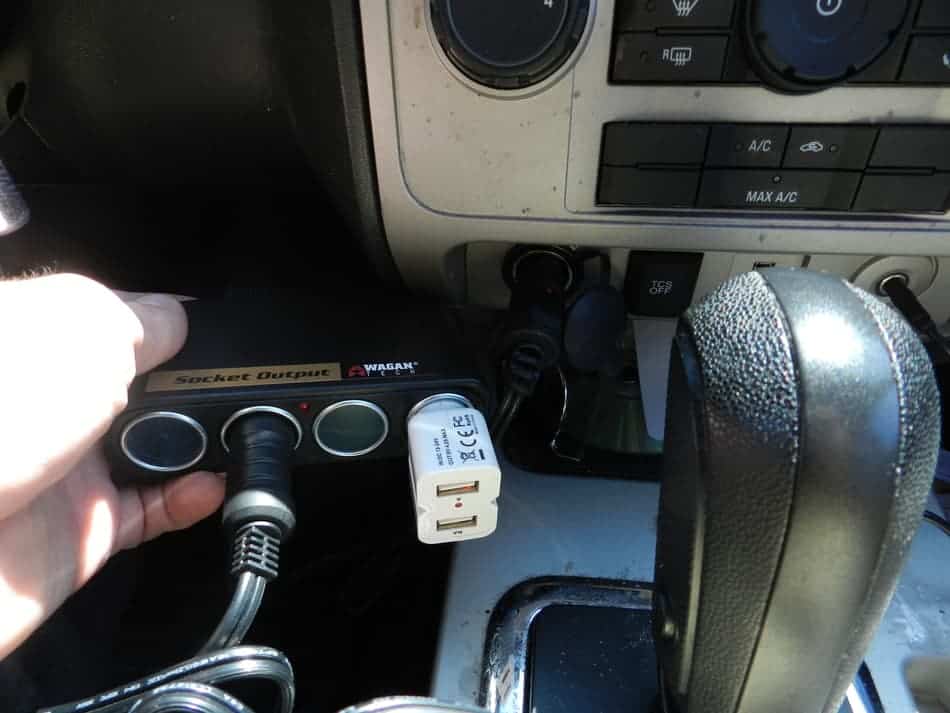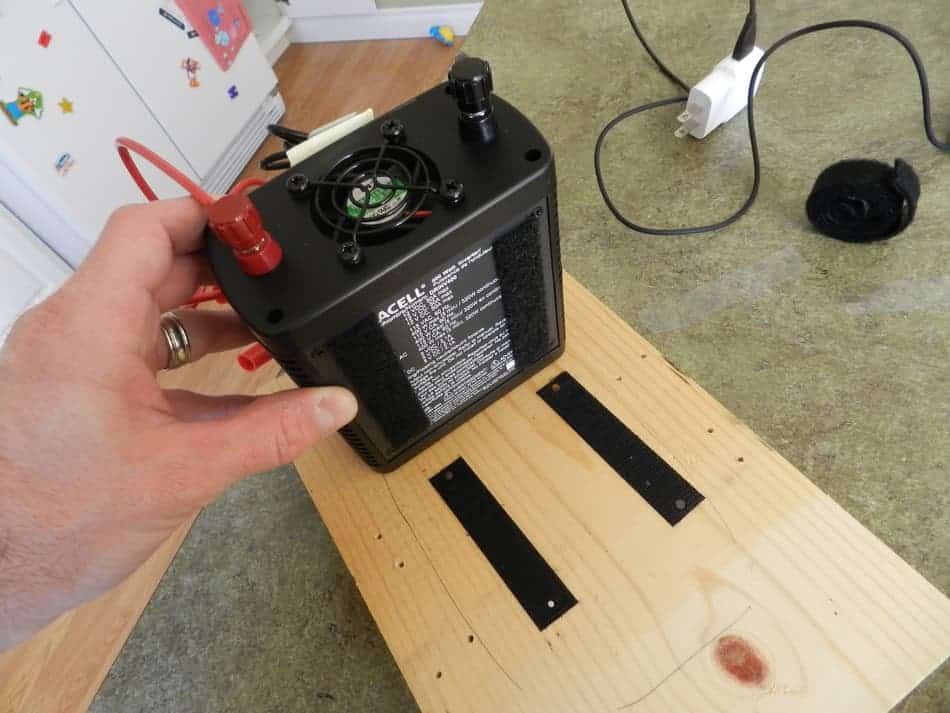When I first got into prepping for power outages, it was for the sole reason that I couldn’t warm my newborn daughter’s bottle of milk during our first power outage with her. I was caught completely unprepared and I vowed to change my circumstances.
My first investment was to buy a DC/AC power inverter and I mostly intended to use it to hook directly to the car battery and use an extension cord to power what I needed. I never really had the intent to use it in the car while driving, but that has all been changing since my daughter is getting older and I am working from home and need to use the laptop as a necessary part of doing business.
I decided to put the title question to the test. I knew I could use it, but I didn’t know exactly what the nuances would be and any limitations. I’m going to share what I’ve learned as we go.
Yes, you can certainly use a power inverter in the car while driving to power your devices. Regardless of the watt rating of your inverter, your car can only supply an average of 150 total watts from its 12-volt accessory port (cigarette lighter socket). Exceeding 150 watts will likely blow a fuse or damage devices.
However, there are a few caveats and limitations to go over before we try to power a something like a microwave or coffee maker and we’ll cover those below.
Check your owner’s manual
Before I could get a true assessment of what my car’s capabilities were, I had to consult with my owner’s manual. In it, I had to figure out what they called the “cigarette lighter outlets”. Ford refers to as the “front and rear power points”. I have one located in the front of the vehicle, and one at the rear of the center console.
I was looking to determine if they were on the same fuse, or if they were separate, and what size fuse they used. I discovered that for my vehicle, they were separate and that one was a normal fuse and one was a cartridge fuse.
They both ended up being the same amp rating: 20.
They are also both “hot” when the key is out of the ignition. Yours may not be, you’ll have to check. My manual didn’t tell me, but I was able to plug in a DC cord with an “on” light indicator into the cigarette lighter port when the key was removed and it lit up for both outlets.
Since I have replacement fuses for the normal ones that you would normally think of but not the cartridge type, I decided to play with that one that I could replace in case I pushed it too far.
So, what does a 20 amp fuse tell me for practical purposes?
If we follow the formula volts x amps = watts, we can calculate what we are able to do. We have the volts (a car battery is 12 volts), and we have the amps of the fuse. That means that 12 x 20 = 240 theoretical watts with which to work.
Many cars have a 15 amp fuse, or a 20 amp fuse. The minimum that you would find would be 10 amp. You’ll need to do your own research.
Total wattage
Now that I know how many watts I have to work with, I like to actually be a little conservative with the number so that I leave room for inefficiencies and surges in units that I’m powering — like a fan kicking on with the laptop or the inverter using power just to stay on, for example.
I’ll pretend that I only have 75% of 240 which would be 180 watts.
As you can see, we are calculating the total watts that the car can supply — not the total watts that the inverter can supply. It does not matter that I ended up using a 400-watt inverter in this example because there is no possible way can I draw 400 watts out of a cigarette lighter plug. It is going to max out somewhere between 180 and 240 watts and will blow a fuse if I exceed that amount.
The only reason having more than 180-240 watts in an inverter would matter would be if I hooked the inverter directly to the car battery with cables.
Check our devices
Now I needed to check my devices by looking at the unit themselves (the power usage is usually on the bottom or reverse of an item) or on the power cord.
I saw that my laptop was going to use about 45-50 watts based on the volts x amps values on the power cord. Phones and tablets usually draw about 5 watts on average. The travel bottle warmer that I have has a DC plug (can fit directly into the cigarette lighter) and uses 18-24 watts. Finally, the travel TV/DVD uses 12 watts.
That’s really all I can imagine powering when my car is running. Laptop, tablet, two phones, portable TV/DVD and the travel bottle warmer all add up to around 100 watts, give or take. That is well under the 180 that I’m allowing myself, and everything should work in theory.
Start plugging them in (tips to make things easier)
When tested, all of these devices powered on just fine and were charging. The 400 watt Duracell inverter that I used in the testing did not make any noise or heat up in any way.

You probably notice in the picture above that I have a few accessories to help me out. The first one is the DC adapter that plugs into the cigarette lighter but gives me 4 new cigarette lighter ports to plug into.
In the end, I have a DC plug for my phone, so I plugged that in, as well as my daughter’s TV/DVD and the travel bottle warmer. Beyond that, I also plugged the inverter into one of the ports as well which left none to spare (save the one that’s in the rear of the center console on a different fuse).
From the inverter, I plugged in the AC units that I would want to use (those that would plug into a normal wall outlet). I plugged in the laptop computer as well as the tablet. To plug in my wife’s phone (not in the pictures), I could either use a DC plug in the back, use a splitter on the inverter to make more AC outlets, or simply plug her phone into the inverter using the USB port.
Before you go on a trip
Before you get excited and head out into the great wide yonder, make sure to take a few things with you. Locate where the fuses are on your car that control the cigarette lighter outlets, and buy some spares. Also, have a tool to extract the fuses as it can be difficult to remove them by hand sometimes. These tools are often sold with or next to packets of fuses in the store.
Keep in mind that your cigarette lighters can provide those 180 watts when the car is running or even when it’s not (assuming you have outlets that are “hot” at all times). With that being said, car batteries are not designed for a steady draw like that over any significant length of time. You will damage your battery in the long run.
If you do draw a lot of watts, be sure to start your car up every half hour or so for 10-15 minutes to let the alternator recharge the battery. Charging a phone or two isn’t going to do much, but when you start adding everything up it starts to tax your battery. Just remember that time you left an interior light on for 12 hours and couldn’t start your car in the morning. Overall, it is best to run the car when charging any significant load.
I recommend having an extension cord as well with a few plug sockets at one end. A 12-foot cord is more than enough. Also, if your inverter does not come with a USB port on it, you can use a USB/DC plug which will give multiple plug-in ports for your phones and devices and provides a faster charge than the USB outlets that might be built into your vehicle (this can be seen in the picture at the top).
Remember that you can only pull so many watts through your cigarette lighter and it will depend on the fuse size of your vehicle. If you have a larger inverter than that capacity, you will need to pop the hood and connect your inverter directly to the battery with clamps to draw more power.
My 400-watt inverter was fully capable of powering our 300-watt kitchen bottle warmer and brought 9 ounces of water in my 18oz Klean Kanteen to 205 degrees Fahrenheit in just over 9 minutes (setting the cap on the canteen to speed the process up). Water this hot is perfect for brewing coffee, which you can read more about in my article here which covers 7 easy ways to make coffee during a power outage or when you’re on the go!

Finally, Velcro makes traveling with inverters so much easier if you plan to use them by connecting directly to your battery. What I mean is that self-adhesive Velcro can be used to attach an inverter to a plain pine board so that your inverter can sit under the hood of your car. I used small tack nails to help secure the ends of the Velcro to the board since I am not sure how well it will adhere to wood over time.

The board gives the inverter something stable to sit on, prevents the inverter from getting too hot from the head below it, and it also prevents the inverter terminals from touching metal which would cause a short and destroy your inverter. Make sure to use a board! It will slide right under your seat when you’re done, and you can pack the cord and inverter away in a small toolbox when not in use.
Conclusion
Get out there and tackle that next road trip with confidence that you can power all of your devices. Keep all of the previously mentioned limitations in mind, and have fun with it! If you get a quality inverter, it should have a feature that shuts itself off if you try to draw too much power. You might still blow a fuse, but at least you won’t fry your inverter. If you’re not sure what works and what doesn’t, feel free to check out my resources page at the top for my recommended gear such as inverters and accessories for dealing with times when you don’t have conventional power.

